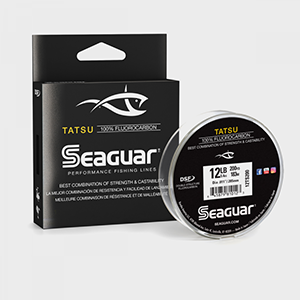
TYING YOUR OWN LEADERS
Fly Fishing Leaders Made Easy
One of my tried and true ways I have saved money for years is to tie my own leaders.
As I get cranked up for a new season, I always build up my supply of fly fishing leaders so that all I have to do is grab a few packets off the pegboard and throw them in my boat bag, vest or fanny pack.
As I was going through my spools of leader tying material, I realized just how long they last and also how much money that means I’ve saved over the years. Now, I have yet to throw out a spool for aging – like we had to often do in the old days. I think the new chemical formulas, and very stable indoor keeping, makes these last … well, since 2013 for some of my spools!
I have had some of my favorite Seaguar Invis-X turn brittle over the years, and if I break a leader at the knots repeatedly, I have come to believe it is either brittling of the fluorocarbon, or fluctuations in the thickness of the line throughout an entire spool (it happens).
I need new Invis-X so rarely, that I never check around, or “shop” for “new-and-improved!” fluorocarbon leader lines very often. The main reason is that means changing out all my leader spools to the new brand.

Last year I did start looking around and found the “new to me” Seaguar Tatsu fluorocarbon, and I guess they reeled me in when I saw the translation for tatsu – dragon. At almost the same time Tatsu entered my awareness, it showed up on the pegboards at Denton’s Academy Sports store. I bought the 20 right away, as this weight is my butt section for my leaders in freshwater. I waited and scraped up the quarters from under my car seat for awhile, and finally went back and bought the 10 pound Tatsu. NOTE: As a brand, I have extreme confidence in just about everything SEAGUAR makes, and let us not forget that they also make tapered fly fishing leaders out of their Japanese solid fluorocarbon!
LEADER CONTROVERSY
Now, here’s where the controversy starts. I am a “radical” when it comes to leader tying formulas. And believe me I have seen a lot of formulas over the year. I know what presentation is, and I have rolled size 18 dries out that landed like the flies they were supposed to be. This, that I do, isn’t that.
Warm water leaders, for me, are supposed to roll out from the butt forward, but do I need a presentation worthy of the fish gods? No, mostly never.
Enter the Controversy – I tie a lot of two section leaders. Yeah, I hear you starting to grumble, “that doesn’t work … can’t be done … etc…” and let me just say YES YOU CAN! Why would you want to reduce the tapers of your warm water leaders?
I do it to save time, save the number of knots (failure points), and to keep grass from fowling those extra knots.
Why is it controversial? The controversy comes from the mismatching of diameters – radical mismatching in my case – a problem that I believe really isn’t a problem anymore. Why is that?
If you follow a couple of my procedures – every time – and use NEW spools of line, not antique spools, I believe the new formulas in mono and fluoro can withstand the past problems encountered with both materials. I believe it because I have done it – for years.
FIRST – Use modern (new) and quality spools of regular fishing line. Buy spools for loading reels, not leader spools, like those used in deep-sea fishing.
SECOND – Know what knots to use to tie your leaders! Tie a few hundred, and it becomes a “no-brainer” after awhile!I use a surgeon’s knot to tie my sections together. It’s small and simple.
THIRD – Tie your knot – whatever it is – and thoroughly wet that thing down!
FOURTH – THIS IS THE KEY! Slowly start bringing your knot to a close and then gradually tight to a cinch. Follow your knot’s instructions (about where to cinch from). Finish it down tight and LAST – TEST the strength. If you overheated your knot, or had any error; TESTING the knots will almost always immediately tell you you got it wrong.
END NOTES –
Remember that monofilament is a FLOATING leader and fluorocarbon is a SINKING leader. Remember that fluorocarbon has little stretch in it, and monofilament has more. Fluorocarbon is more abrasion resistant. The fly will sink mono, but it does so slowly – when the fly is properly matched. Some species need that stretch and some need as little stretch as possible.
Larger diameter leaders do not cast as easily and sink more slowly than smaller diameters.
Cost on good fluorocarbon leader materials is “high” up front, but it factors out over YEARS! All you have to do is get started, and the savings come after about SIX fluorocarbon leaders you’ve tied! I have discovered that cheaper mono, like ANDE, is actually better than the extremely supple and more expensive monos. That is because its stiffness keeps it from tangling easily.
All fluorocarbons are not alike. Look for the term, “solid,” or sometimes “100-percent,” to help in selecting good quality fluorocarbon. HOWEVER, that “100-percent” moniker can mean the fluorocarbon coating is “100-percent,” so buyer beware! My least favorite leader tying material has proven to be those “hybrid” types – made from both mono and fluoro.
If you read this much, subscribe, and you will be notified when more stories appear here! And be sure to subscribe to the YouTube Channel TexasFlyCaster today as well. You will not be assimilated into the borg.
